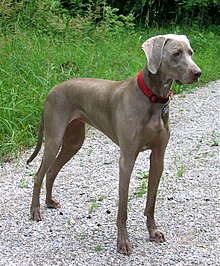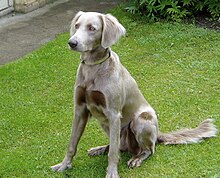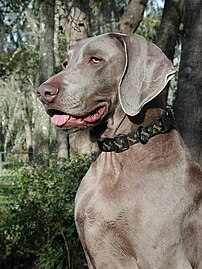Weimaraner
| Weimaraner | |||||||||||||||||||||
|---|---|---|---|---|---|---|---|---|---|---|---|---|---|---|---|---|---|---|---|---|---|
 Short-haired bitch, two years old | |||||||||||||||||||||
| Origin | Germany | ||||||||||||||||||||
| |||||||||||||||||||||
| |||||||||||||||||||||
| Dog (domestic dog) | |||||||||||||||||||||
The Weimaraner[a] is a German breed of hunting dog of medium to large size, with history going back at least to the early nineteenth century.[3] Early Weimaraners were used by royalty for hunting large game such as boar, bear, and deer. As the popularity of hunting large game began to decline, Weimaraners were used for hunting smaller animals like fowl, rabbits, and foxes.
The name comes from the Grand Duke of Saxe-Weimar-Eisenach, Karl August, whose court, located in the city of Weimar (now in the state of Thuringia in modern-day Germany), enjoyed hunting. The Weimaraner is an all-purpose gun dog, and possesses traits such as speed, stamina, great sense of smell, great eyes, courage, and intelligence.[4] The breed is sometimes referred to as the "grey ghost" of the dog world because of its ghostly coat and eye color along with its stealthy hunting style.[4]
History[edit]

The Weimaraner was kept in the Weimar court in the 19th century and carried a good deal of Leithound ancestry.[1] Two theories propose that they descended from the Chien-gris,[5] or from the St. Hubert hound, whose descendant is the bloodhound.[6] In the beginning, Germany's Grand Duke Karl August used the Weimaraner to hunt big game like wolves, bears, and boar, but as Europe's number of big game animals decreased, the Weimaraner turned into a point-and-retrieve hunter of small game.[7] The breed arrived to America in the late 1920s, and its popularity increased in the 1950s,[7] largely because of celebrities like Grace Kelly, President Dwight D. Eisenhower, and Dick Clark. The famous artist and photographer William Wegman increased the breed's popularity even more with his world-famous Weimaraner portraits and video segments.
Description[edit]

The eyes of the Weimaraner may be light amber, grey, or blue-grey, and the ears are long and velvety.[citation needed]
In November 2009 and on 1 January 2010, the United Kennel Club (UKC) removed the disqualification from Blue and Longhair Weimaraners. A black coat remains an automatic disqualification, though a small white marking in the chest area only is permitted. Dogs with blue coats are disqualified from conformation/show competition,[8] but are recognized as purebred Weimaraners by the AKC.
A long-haired variety is recognized by most kennel clubs around the world except the American Kennel Club. The long-haired Weimaraner has a silky coat with an undocked, feathered tail.[citation needed]
According to the Fédération Cynologique Internationale standard, the male Weimaraner stands 59 to 70 cm (23 to 28 in) at the withers. Females are 57 to 65 cm (22 to 26 in). Males normally weigh about 30–40 kg (66–88 lb). Females are generally 25–35 kg (55–77 lb).[1] A Weimaraner should give the appearance of a muscular, athletic dog.
- A long-haired bitch
- Blue is not an accepted colour
Health[edit]
According to the Orthopedic Foundation for Animals, Weimaraners enjoy low rates of dysplasia. The breed is ranked 102nd of 153 total breeds and has a very high test rate and a very high percentage of excellent rating among those dogs tested.[9]
Other health issues include:
- Cryptorchidism[10]
- Distichiasis[10]
- Elbow dysplasia[11]
- Entropion[12]
- Pituitary dwarfism[10][12]
- Hypertrophic osteodystrophy[12]
- Hypomyelinogenesis[12]
- Hypothyroidism[10]
- Progressive retinal atrophy
- Renal dysplasia[12]
- Von Willebrands Disease[10]
Notes[edit]
References[edit]
- ^ a b c d e f g "Weimaraner standard" (PDF). FCI. Retrieved 25 April 2017.
- ^ O’Neill, D. G.; Church, D. B.; McGreevy, P. D.; Thomson, P. C.; Brodbelt, D. C. (2013). "Longevity and mortality of owned dogs in England" (PDF). The Veterinary Journal. 198 (3): 638–43. doi:10.1016/j.tvjl.2013.09.020. PMID 24206631. "n=26, median=12.6, IQR=11.1–13.5"
- ^ "Weimaraner". The Kennel Club. Retrieved 26 December 2016.
- ^ a b "Weimaraner | Gundog breeds | Gundog Journal". gundog-journal.com. Retrieved 26 April 2021.
- ^ Deep, John. "Weimaraner". 2puppies. Retrieved 26 December 2016.
- ^ Kočov, Dr. Jana. "Weimaraner Breed History". Royal Splendour.
- ^ a b "Weimaraner Dog Breed Information". American Kennel Club. Retrieved 26 April 2021.
- ^ Weimaraner Page
- ^ "Weimaraner". OFFA.
- ^ a b c d e "List of common problems afflicting Weimaraners". Weimaraner Club of America.
- ^ FITZPATRICK, NOEL; SMITH, THOMAS J.; EVANS, RICHARD B.; YEADON, RUSSELL (February 2009). "Radiographic and Arthroscopic Findings in the Elbow Joints of 263 Dogs with Medial Coronoid Disease". Veterinary Surgery. 38 (2): 213–223. doi:10.1111/j.1532-950X.2008.00489.x. PMID 19236680.
- ^ a b c d e "Weimaraners". Canine Inherited Disorders Database. Archived from the original on 19 February 2007.


 French
French Deutsch
Deutsch


